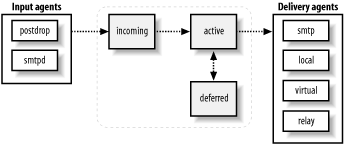How qmgr Works
Figure 5-1 illustrates how messages move through the queue. The
incoming queue is where messages first enter Postfix. The queue manager
provides protection for the queue filesystem through the queue_minfree parameter. The default value is 0. You can make sure the
disk that stores your queue doesn’t run out of space by setting a
limit.
 |
From the incoming queue, the queue manager moves messages to the active queue and invokes the appropriate delivery agent to handle them. For the most part, if there are no problems with delivery, movement through the queue is so fast that you won’t see messages in the queue. If Postfix is trying to deliver to a slow or unavailable SMTP server, you may see messages in the active queue. Postfix waits 30 seconds to decide if a remote system is unreachable.
A message that cannot be delivered is placed in the deferred queue. Messages are deferred only when they encounter a temporary problem in delivery, such as a temporary DNS problem or when a destination mail server reports a temporary problem. Messages that are rejected, or encounter a permanent error, are immediately bounced back to the sender in an error report and don’t stay in the queue.
Deferred Mail
Messages in the deferred queue stay there until they are
either delivered successfully or expire and are bounced back to the
sender. The bounce_size_limit ...
Get Postfix: The Definitive Guide now with the O’Reilly learning platform.
O’Reilly members experience books, live events, courses curated by job role, and more from O’Reilly and nearly 200 top publishers.

